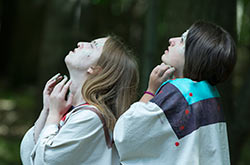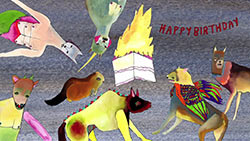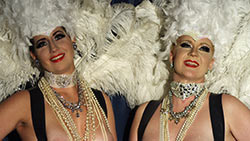Program
Thursday, May 15, 7:00PM
PERFORATIONS 1 - FUTURE, NATURE, FICTION, FEEL
Bark to the Land
 After the family farm is sold off for development, one dog decides he must risk everything to get out of the sprawling city and find a way ... Bark to the Land.
After the family farm is sold off for development, one dog decides he must risk everything to get out of the sprawling city and find a way ... Bark to the Land.
Trade
 Trade is an experimental video short exploring concepts of borders and trade, and their relationship to notions of collective history and national identity in the North American colonial context. The work seeks to deconstruct and abstractly layer Indigenous and colonial histories, looking at the (visible and invisible) borders that exist within our communities, cities, economies, and nations.
Trade is an experimental video short exploring concepts of borders and trade, and their relationship to notions of collective history and national identity in the North American colonial context. The work seeks to deconstruct and abstractly layer Indigenous and colonial histories, looking at the (visible and invisible) borders that exist within our communities, cities, economies, and nations.
Tableau
 JT is a filmmaker in a small post-industrial town with big ideas about the future, the far-off future. He struggles to express his LoFi-SciFi vision, but is thwarted, in part by his own ambitions. He finds an unlikely alliance with the tween next door and her besty. At first the tweens are antagonistic to this thoughtful auteur, but they develop a shared language and become his muses along with his own toy poodles. Tableau toggles back and forth between JT's daily awkwardness and his grand cinematic vision.
JT is a filmmaker in a small post-industrial town with big ideas about the future, the far-off future. He struggles to express his LoFi-SciFi vision, but is thwarted, in part by his own ambitions. He finds an unlikely alliance with the tween next door and her besty. At first the tweens are antagonistic to this thoughtful auteur, but they develop a shared language and become his muses along with his own toy poodles. Tableau toggles back and forth between JT's daily awkwardness and his grand cinematic vision.
Camp Butchison
 There are times in many of our lives that leave us feeling not quite 'butch enough.' For truly hopeless cases, there's only one place left to go: Camp Butchinson. A brutal place run by sadistically macho counselors who don't hesitate to use force, the camp's narrow vision of masculinity quickly makes campers thirst for gruesome revenge. An affectionate homage to the tender-hearted, Camp Butchinson delivers a feel-good message of fag-tastic proportions.
There are times in many of our lives that leave us feeling not quite 'butch enough.' For truly hopeless cases, there's only one place left to go: Camp Butchinson. A brutal place run by sadistically macho counselors who don't hesitate to use force, the camp's narrow vision of masculinity quickly makes campers thirst for gruesome revenge. An affectionate homage to the tender-hearted, Camp Butchinson delivers a feel-good message of fag-tastic proportions.
Thursday, May 15, 9:00PM
PERFORATIONS 2 - SPACEY, VOYAGE, ETHEREAL, IMAGE
The Fourth Dimension
 In a parallel universe, monoliths loom over a desert landscape. Time and space are distorted in a dimension that defies the laws of geometry and physics.
In a parallel universe, monoliths loom over a desert landscape. Time and space are distorted in a dimension that defies the laws of geometry and physics.
Lats Yerk
 Lats Yerk tells an ancient future story of a clan of alien ancestor beings who, while on a quest searching for an embodied knowledge of the universe, stumble upon a portal. Through the portal and on the other side, they realize their own bodies are the actual vessels for the universal wisdom they seek. In their enlightenment, they dance in celebration between the neon folds of space and time. They are the spirit guides for the magical unknown.
Lats Yerk tells an ancient future story of a clan of alien ancestor beings who, while on a quest searching for an embodied knowledge of the universe, stumble upon a portal. Through the portal and on the other side, they realize their own bodies are the actual vessels for the universal wisdom they seek. In their enlightenment, they dance in celebration between the neon folds of space and time. They are the spirit guides for the magical unknown.
A Day for Cake and Accidents
 A Day for Cake and Accidents features a cast of animal characters -- each of a different, though often indeterminate, species -- who struggle with impending astrological despair and engage in absurdist dialogs, confessing various melancholic desires and transgressive secrets in poetic cartoon abjection. A Day for Cake and Accidents is the third in a series of short collaborative animations.
A Day for Cake and Accidents features a cast of animal characters -- each of a different, though often indeterminate, species -- who struggle with impending astrological despair and engage in absurdist dialogs, confessing various melancholic desires and transgressive secrets in poetic cartoon abjection. A Day for Cake and Accidents is the third in a series of short collaborative animations.
Hoshi Neko (Little Star)
 This 16mm B&W cut-out animation borrows narrative tropes from early Atari video games, silent films, and anime cartoons, offering a weird story and hybrid aesthetic. The narrative is based on the imagined adventures of the singer's lost cat, Hoshi. Hoshi eats a koi fish that emerges angry from his digestive system. The koi enlists the help of a pug to exact revenge, and the three characters embark on an epic chase through the cosmos. Their journey brings them through wormholes and across poisonous planets where their skin is melted off by acid rain.
This 16mm B&W cut-out animation borrows narrative tropes from early Atari video games, silent films, and anime cartoons, offering a weird story and hybrid aesthetic. The narrative is based on the imagined adventures of the singer's lost cat, Hoshi. Hoshi eats a koi fish that emerges angry from his digestive system. The koi enlists the help of a pug to exact revenge, and the three characters embark on an epic chase through the cosmos. Their journey brings them through wormholes and across poisonous planets where their skin is melted off by acid rain.
Friday Vacation (Trailer)
 The archives of the National Naval Institute were founded in 1985 after the donation of the personal effects of Robin Quickly. The donation, which mostly consisted of post- cards, was given to the institute without any explanation of the items. Robin Quickly, though never in the navy, was a well-traveled sailor. Twenty years after the archives were founded a documentary crew started on the journey to uncover the life of Robin Quickly.
The archives of the National Naval Institute were founded in 1985 after the donation of the personal effects of Robin Quickly. The donation, which mostly consisted of post- cards, was given to the institute without any explanation of the items. Robin Quickly, though never in the navy, was a well-traveled sailor. Twenty years after the archives were founded a documentary crew started on the journey to uncover the life of Robin Quickly.
Hiding in the Lights
 Two female performers – as ringmasters, pining lovers and autonomous artists in a personal union – live through “moments of disclosure” before an imaginary audience. With verve, wit and queer femme-ness, they unmask the performance space as a sexualized game subject to viewing conventions, contrasted through shots of the deserted Palau de les Arts Reina Sofía.
Two female performers – as ringmasters, pining lovers and autonomous artists in a personal union – live through “moments of disclosure” before an imaginary audience. With verve, wit and queer femme-ness, they unmask the performance space as a sexualized game subject to viewing conventions, contrasted through shots of the deserted Palau de les Arts Reina Sofía.
What Was A Wild Night
 Using paint and paper cutouts on glass, characters were created and scenes improvised in direct response to the soundtrack. The result is reminiscent of a live drawing populated by meandering psychedelia and dark forms that transform, vanish and rise again. What Was a Wild Night has a loose narrative that alternately aligns itself with the lyrics and playfully breaks off into its own dream-like vision.
Using paint and paper cutouts on glass, characters were created and scenes improvised in direct response to the soundtrack. The result is reminiscent of a live drawing populated by meandering psychedelia and dark forms that transform, vanish and rise again. What Was a Wild Night has a loose narrative that alternately aligns itself with the lyrics and playfully breaks off into its own dream-like vision.
Benjamin's Flowers
 This animation follows the inner-monologues of Benjamin, who spends all day at home next to his guarded dog. As Benjamin explains why he prefers to be alone, his mind occasionally gives way to surreal fantasies of sexual abandon. Underscoring the distance between fantasy and reality in his daydreams, Benjamin and his imaginary suitors take the form of insects and fish. Mustachioed spiders seduce him at a bar. Fish play koi and blow kisses under the sea. Even in his dreams, however, Benjamin is unable to connect with any of his mates on an emotional level. We are ultimately left with a protagonist unable to differentiate between fantasy and reality, but who still cherishes the accompaniment of fantasy lovers.
This animation follows the inner-monologues of Benjamin, who spends all day at home next to his guarded dog. As Benjamin explains why he prefers to be alone, his mind occasionally gives way to surreal fantasies of sexual abandon. Underscoring the distance between fantasy and reality in his daydreams, Benjamin and his imaginary suitors take the form of insects and fish. Mustachioed spiders seduce him at a bar. Fish play koi and blow kisses under the sea. Even in his dreams, however, Benjamin is unable to connect with any of his mates on an emotional level. We are ultimately left with a protagonist unable to differentiate between fantasy and reality, but who still cherishes the accompaniment of fantasy lovers.
For Claire
 Excerpt from a longer piece, originally shown as a live projection for Grimes (aka Claire Boucher) at the New Museum in NYC. This edit has a new electronic sound score by Alice Cohen. A visual meditation within a personal dreamscape, simultaneously antique and futuristic, For Claire is an internal exploration of the sacred feminine discovered through layers of swirling paint and animated found imagery.
Excerpt from a longer piece, originally shown as a live projection for Grimes (aka Claire Boucher) at the New Museum in NYC. This edit has a new electronic sound score by Alice Cohen. A visual meditation within a personal dreamscape, simultaneously antique and futuristic, For Claire is an internal exploration of the sacred feminine discovered through layers of swirling paint and animated found imagery.
Lateral Transfer (Black)
 A series of extreme close-ups of moving ink droplets suspended in water on a light table. An exploration of material and the perception of scale.
A series of extreme close-ups of moving ink droplets suspended in water on a light table. An exploration of material and the perception of scale.
How to Quit Smoking at the Moon Hotel
 A neo-nocturne detailing a small transaction staged in a coin-operated elevator at a downloaded lunar hotel. Starring director Jessie Stead as 'a moonlighter'.
A neo-nocturne detailing a small transaction staged in a coin-operated elevator at a downloaded lunar hotel. Starring director Jessie Stead as 'a moonlighter'.
The Advice Shape
 The sense that you are about to be shown something wrong lingers throughout this bizarre semi-narrative. Appropriated imagery of natural disasters, paper crafts, mutated animals, abject beauty and genocide form an exquisite corpse of uncanny connectivity with chirrupy 1950s advertising music or romantic classical. Is this a test? A sensual strip curtain of shiny black pvc suddenly slides in front of the frame - further teasing the relationship with the material act of viewing and constructing meaning, and you are faced with a lo-fi gameshow puzzle that provides no opportunity to engage and a live, rubber-headed nurse continues your aptitude test. "You have a split emotional register," you are told, "would you like me to reseal it?"
The sense that you are about to be shown something wrong lingers throughout this bizarre semi-narrative. Appropriated imagery of natural disasters, paper crafts, mutated animals, abject beauty and genocide form an exquisite corpse of uncanny connectivity with chirrupy 1950s advertising music or romantic classical. Is this a test? A sensual strip curtain of shiny black pvc suddenly slides in front of the frame - further teasing the relationship with the material act of viewing and constructing meaning, and you are faced with a lo-fi gameshow puzzle that provides no opportunity to engage and a live, rubber-headed nurse continues your aptitude test. "You have a split emotional register," you are told, "would you like me to reseal it?"